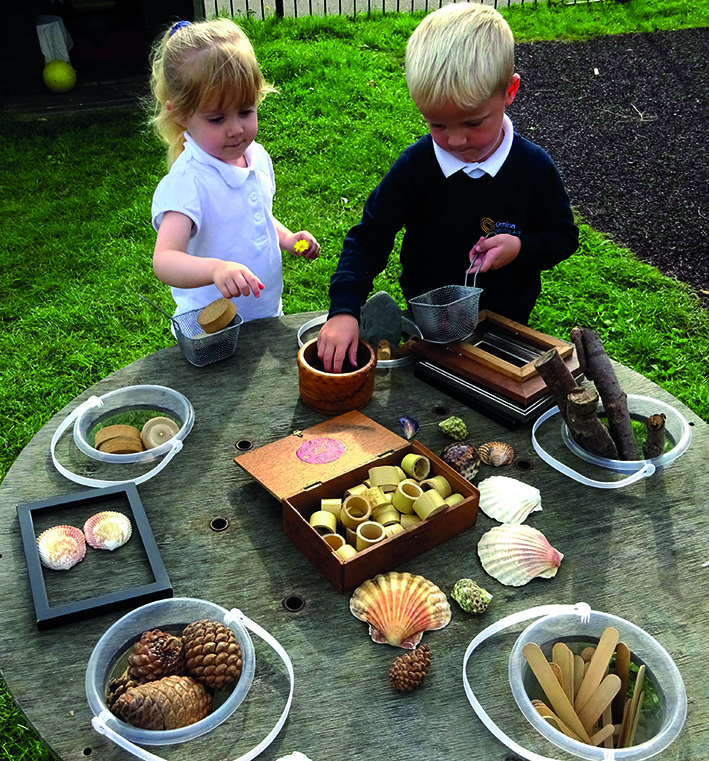
Enhancements that are added to the environment can encourage children to compare quantities of objects, an important part of the Mathematics area of learning.
Our nursery staff have a key role in modelling the comparison of quantities and related language such as ‘more than’ or ‘fewer than’. Good opportunities for this occur when food, either real or pretend, is involved. At the snack table, the adults may make comparisons of quantities of different fruit slices, pointing out if one person has more banana but the other has more apple, for example. In the home corner, they may start discussions about the number of cups needed at the dinner table when more children join, or whether a child has more or fewer candles in their piece of playdough birthday cake. As time goes on, the children often initiate these comments and discussions on their own, having had these comparisons of quantities modelled to them.
SHOPPING ROLE PLAY
 Shopping role-play areas or stations can be ideal enhancements for numerous mathematical learning and development opportunities.
Shopping role-play areas or stations can be ideal enhancements for numerous mathematical learning and development opportunities.
Around harvest time we had a focus on farms, including making links to where our food comes from, and we had a tractor come into the school grounds to visit the nursery children. With the children enthusiastic and engaged with learning about farms and harvest we decided to make a ‘farm shop’ role-play area. This way the children could make links to the information they had learnt about farming, and new opportunities could arise for comparison of quantities, numeral recognition, and matching number to quantity. Photographs on the wall of harvest and tractors inspired conversation about their previous learning experiences. We placed some covered crates on top of each other to create a counter and behind that we had a till and small clipboards for mark-making. We used authentic fruit and vegetables for the children to play with in the shop which we displayed in some sectioned trays for cutlery.
The shop had some string bags and shopping baskets for children to put their various quantities of groceries in. Lots of discussion took place about how much the children had: ‘You have lots of potatoes in your bag, you have the most. That’s going to cost lots of money!’ one boy said to another. An egg tray was put on the counter with some numbered discs. The children noticed that the sprouts fitted nicely in the egg tray and some put various quantities of them in the tray and then found the corresponding numbers.
NUMBER PLAY
At our nursery we value the use of ‘loose parts’ due to the open-ended nature of them and the limitless possibilities they provide. Indoors we have various loose parts available, and children playing with them often compare quantities either with an adult first modelling or independently.
Our loose parts include bamboo slices, natural sticks, lolly sticks, small craft sticks, stones, pinecones, shells, wood slices and corks, to name a few. The staff are always on the lookout to add new loose parts that might challenge and inspire the children. I found some curtain rings and placed them next to a mug tree that another staff member had found in a charity shop. This enhancement led to comments and questions linked to quantities. ‘This side has one, but this other side has four, I need to make them the same!’ a boy commented as he went on to put four rings on each branch. A girl made links to her own experiences of Christmas, stating, ‘This is my Christmas tree and I’m going to put the baubles on.’ She went on to discuss which branches had more and less baubles. Some children combined the curtain rings with the bamboo slices and compared the varying quantities of each type.
Outside we have a loose-parts table that we made from a large cable reel that had been donated to us. We had five holes cut into it that were the correct size to place our clear buckets into. We enhance the table by regularly changing up the loose parts that are available. The buckets are not fixed so the children can carry them to another area of the playground to integrate them into their imaginative play. This can encourage comparison of quantities. For example, the children enjoy handling small fryer baskets and collecting loose parts inside. Children can often be overheard counting how many they have in the basket and comparing their quantities together.









